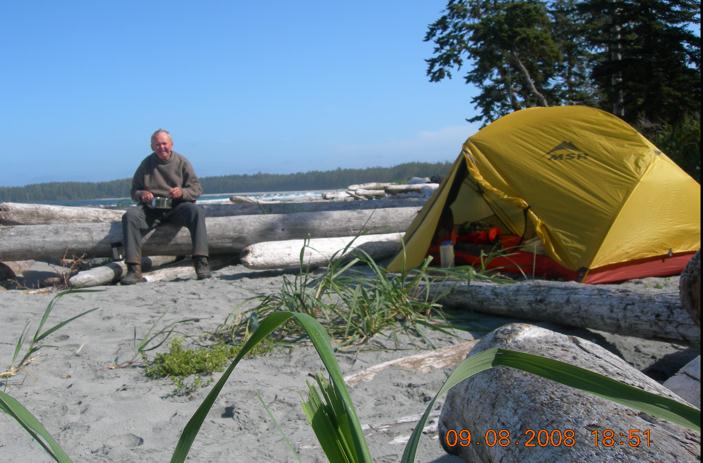 |
| Laval (with bears) at Cape Scott |
 |
Vancouver Island, September 12, 2008. Hello, Friends: Some creatures look cuddly, and are. Some, though, look cuddly and definitely are not. One evening a week or so ago I sat in my van at the far north-western tip of this beautiful island, shining in gorgeous weather, and watched a black bear destroy the inside (yes -- the inside) of a new-looking Toyota that had driven across the continent from Quebec to visit Cape Scott, a spectacular wilderness area reached on weary feet through mud and primeval rain-coast forest. It's one of the adventure pilgrimages here. The only way to get there after the road ends is by Shanks's pony, carrying your own food and survival gear through ancient wetland and dense forest of yellow and red cedar, hemlock and some of the most magnificent giant spruce trees on the planet. For a lone foot-slogger the scope of the place, strange with the bright green moss of humid, silent forest, is rivetting. Size, inaccessable terrain and the unknown round each turn of the rough, muddy track across a network of slippery tree-roots, make you feel rather small and vulnerable. Besides bears there are cougars and wolves to raise the tension that little bit extra. Unarmed, all you have to deal with a marauding beast is a pepper spray, your wits and a good speech (there's nothing like preparing a few sharp words). Anyway -- I drove my Ford van the 500-odd kilometres from Brentwood, down here by Victoria, to the timber and fishing town of Port Hardy up north, veered off onto 50 kilometres of gravel logging road and arrived, sliding round bends in a cloud of red, sandy dust at the settlement of Holberg, deep at the head of a beautiful Pacific inlet. Most of the names round here -- Nissen Bight, Nels Bight, Hansen Lagoon -- are Danish. In the early 1900's a hundred or so hardy Danish settlers established an agricultural and fishing community. Traces are all around. It failed because communications didn't enable the settlers to get their produce out to market. (Actually, it failed because the Canadian government took fright at the Danes' successful establishment of a separate, vigorous community and failed to build a promised road). So here I am at the trailhead, sitting in my van, when a black bear (there are said to be no grizzlies on Vancouver Island, though stories suggest that isn't necessarily true. They're good swimmers) -- when a black bear emerges from the forest and comes right up. Bold with the brass of the total novice, I open the van door, tell it to go away -- and it runs. (They run at the speed of race-horses -- up trees as well -- which sort of limits your escape plan. And the other myths about bears not seeing or hearing very well are just that -- myths. Moreover, when it comes to smelling, few animals are as sharp as bears. Everything from honey to stinking garbage. 200-pound cuddly buggers with appetite about sums them up). However -- the bear scarpers and I think I'd better root around in the van for my camera in case I see another (little do I know yet how many there are around San Josef!). Next when I look up the bear's back -- this time on the roof of the Toyota parked not 20 feet away. Then it's down on the ground rocking the car 'till I think it's going to go over. Then there's a cloud of flying glass as it punches through a rear side window and climbs in to start the havoc among food containers, coolboxes and poly bags, tearing and flinging them around inside and outside the car (in disgust at cheap brands, I wonder?) and tearing up the interior trim. It's impressively untidy. The car-park's strewn with more half-chewed food litter than you'd imagine could possibly be packed into a car. It would have been kinder to the car to have tossed a stick of gelignite in. At this point I recall what I've been told about bears getting stuck on food fads and decide discretion is by far the better part of valour, so I retreat in my van to Doug Desjarlais' place a kilometre back down the track. To cut a long story short, after much debating with Doug (a remarkable and very friendly man, Metis-descended, who lives alone on his 'heritage' camp-site in a wooden hut full of computers and assorted tackle) I spend the night (very comfortably in the fitted bed) in the van, park it outside Doug's place with all the van curtains drawn so the bears can't see what's inside -- but see later!) and set off yomping alone into the jungle next morning. It's 17.8 kilometres to where I'm headed at Nels Bight, a beautiful white sandy beach adjacent to the point of Cape Scott. My rucksack, fully geared, weighs about 40 pounds -- and feels it. No pain, no gain, as they say. After last night's show I'm rather more alert about predatory animals but my powerful pepper spray's at the ready on my hip belt, with the safety catch off. I practice drawing it like lightning, right-hand across the chest, Clint Eastwood style. Come on, bears! (I also did a trial shot at home before I left. It shoots out a wicked red wedge of pepper, effective at 30 feet, with the recoil of a small-calibre hand-gun. And woe betide if you dally around. I -- the shooter -- was blind with streaming eyes for a full ten minutes. Which I assume leaves two of us, me and the bear, staggering around blindly on the same spot). Seven weary hours later, I'm on the beach at Nels Bight. It's quite simply beautiful. I pitch my Hubba Hubba (that's my two-man tent) in the sand at the head of the beach beyond the tide-line. They're neap tides right now, so I calculate (correctly!) the next tide won't reach me during the night. I get my stove and a cup of tea going, eat a couple of pre-cooked Red Barn turkey sausages, a bagel and a handful of nuts and raisins and decide there and then I'm going to eat a shed-load tomorrow so I don't have to carry it back. I needn't have worried over-much. Because of the bear problem, and their facility for smelling out the faintest culinary whiff, you're admonished never to leave food in your tent. Or even cook in your tent. Instead you pack it all up and lock it inside a steel food cache. They're dotted about. Which is what I did. No bear touched my food. The mice got it. Soon I'm bedded comfortably in my down sleeping bag. There's little wind, only the hum and swish of the Pacific coming ashore. Miraculously (though I did watch the weatherfaxes for a decent window) there's no sign of rain in the wettest of spots in British Columbia -- 330 centimetres on average each year. It's mid-morning when I surface. There are bear paw-marks all around the tent. Early Pacific coast fog has cleared, it's a cloudless sky, white rollers are hitting the empty, mile-long white sand beach. It's another brilliant, brilliant day in paradise, far from recession and gloom. Another night in the ranger's cabin, welcomingly left empty and fully-equipped on the edge of Nels Bight -- what a view! -- with a couple of other similar back-packing souls arriving, then back through the forest, 19 kilometres this time, to the trailhead. I'm bushed, of course -- but I've done it. It's all a mind-game. It always amazes me how easy the last kilometre is, when you're in sight of the goal. But I'm sweating; if not at the physical effort, at the news brought by my hiking friends at Nels Bight that another vehicle has been wrecked by two bears. By now I've remembered that I forgot to draw the curtains on my van's sliding side door. There's a shiver at what destruction I might find. I see with relief when it comes into view outside Doug's hut that everything's OK. The beer's in the coolbox. I knock the top off and gulp it with the manners of a black bear. A short while down the road at Holberg I meet Doug again and friends in the pub for a meal (Holberg logger size). The marauding bears have been shot dead. There's no uneducating them. But it's still sad. I never saw any cougars, or wolves. It's a fair bet they saw me, though. What next? Nootka Island, on Vancouver Island's wild west coast, perhaps. Where Captain James Cook landed in the 1770's and started it all. Best wishes, Ian 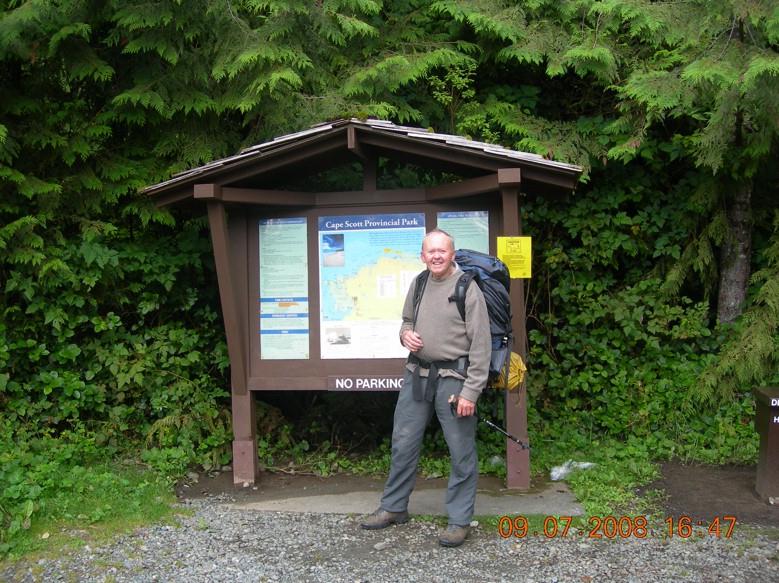 Setting out from the trailhead for Cape Scott. 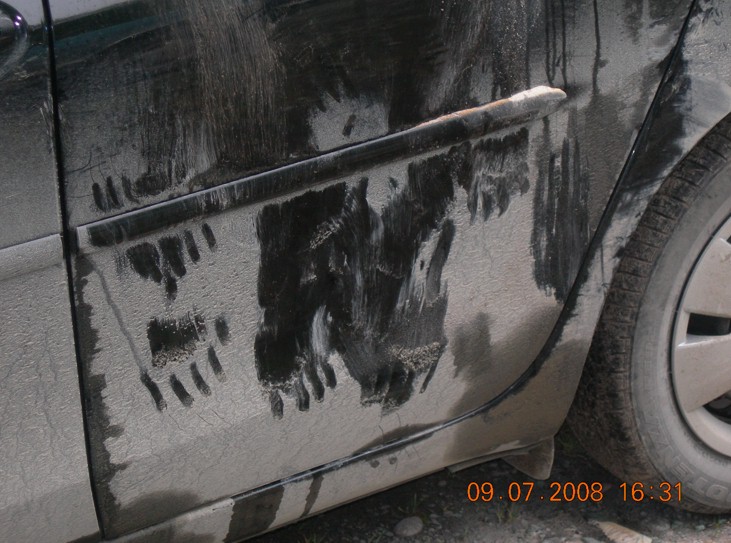 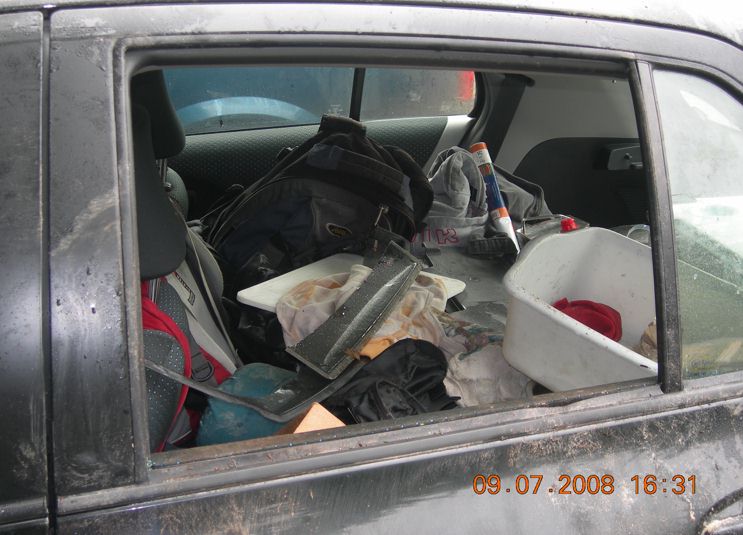 Black bear's visiting card. 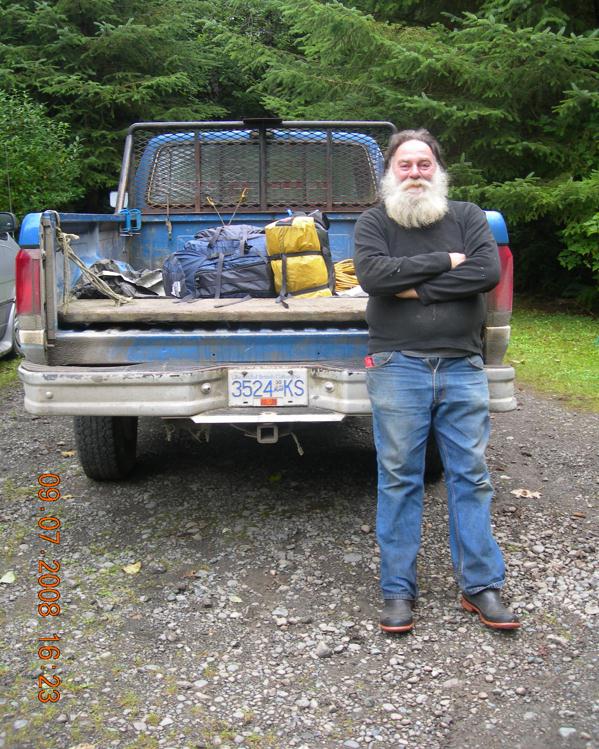 Doug Desjarlais, Cape Scott man. 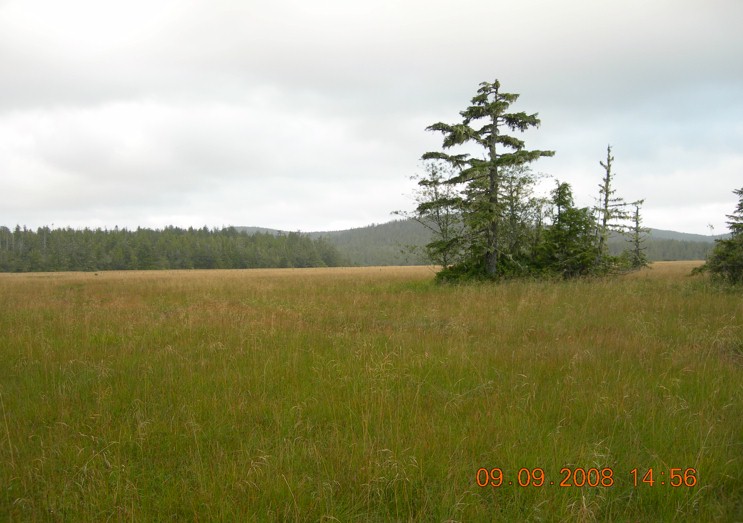 The meadow created by Danish settlers at Hansen Lagoon, Cape Scott, in the early 1900's. 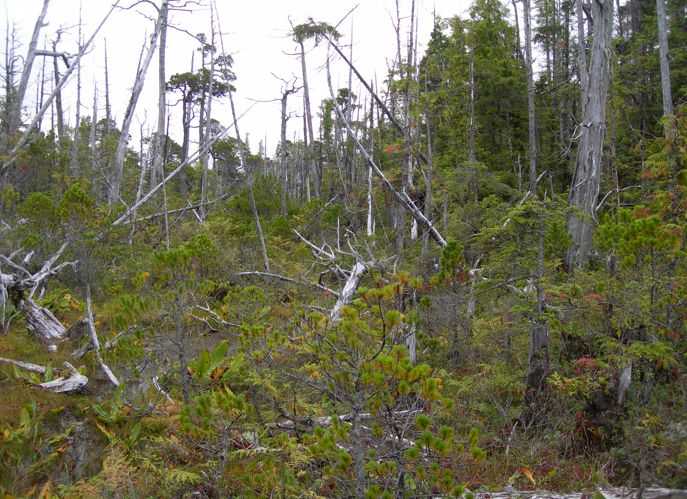 Typical cedar wetland forest on the trail to Cape Scott.  Nels Bight, Cape Scott. Click here to see the full view. |